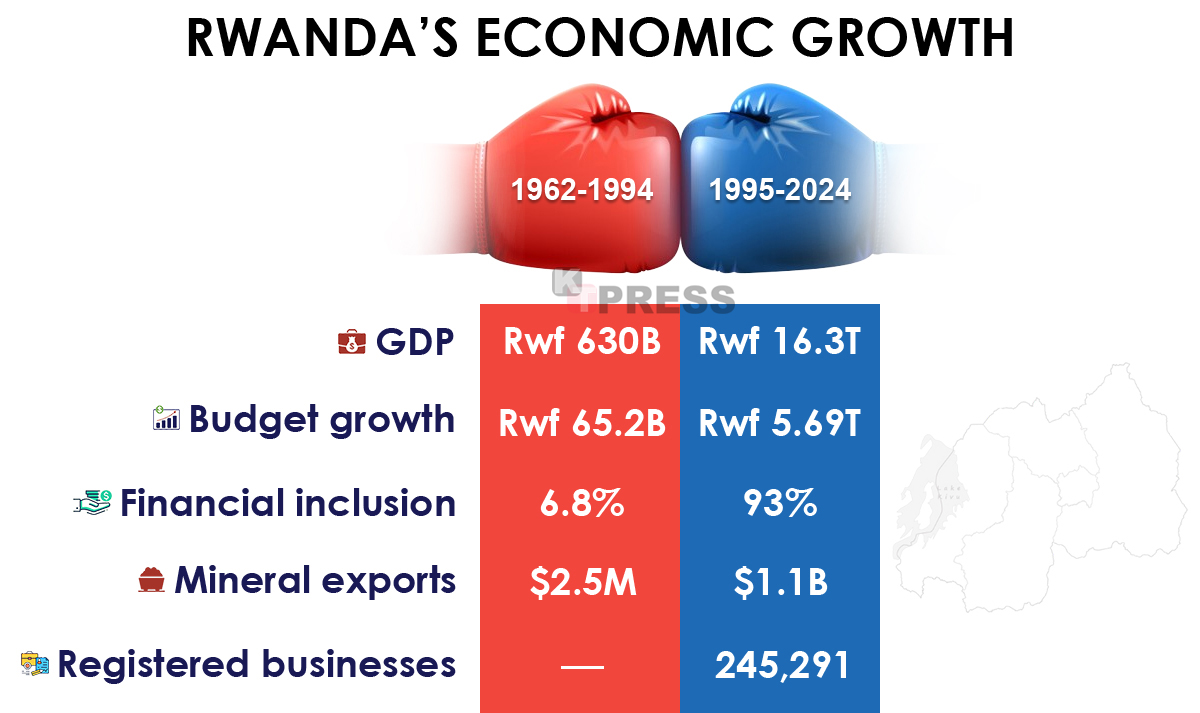
Rwanda stands at a crossroads as it heads into the general election; parliamentary and presidential due July-September, 2024. To shed light on this critical moment, we are launching a groundbreaking data project – a deep exploration of Rwanda’s transformation over the past 30 years, as seen from the prism of the previous 30 years. .
This isn’t just a story of rebuilding; it’s a remarkable metamorphosis. Rwanda, ravaged by the 1994 genocide against the Tutsi, doesn’t appear about to stop the move. Buckle up, because this is just the first series! Over the next few days, we will unveil a series using only data of 30 indicators: education, infrastructure, health, institutions, social-political stability, and even tourism. We’ll be sharing groundbreaking data, some you’ve never seen before.
A Glimpse into Rwanda’s Transformation
Here’s a sneak peek into Rwanda’s progress, comparing two distinct periods: 1962-1994 and 1995-2024.
From Dependence to Economic Diversification: In 1989, Rwanda’s mineral exports – was, at a mere $2.5 million. Fast forward to 2023, and that figure has skyrocketed to a staggering $1.1 billion. This economic leap signifies a crucial shift – Rwanda is no longer solely dependent on one source of income.
Investing in the Future: By 1994, some 2,870 Rwandans held university degrees. Today, that number has exploded to a staggering 431,606 graduates (as of 2022). This exponential growth in education is a testament to Rwanda’s commitment to its greatest asset – its people.
Paving the Way for Progress: Imagine a country where traveling long distances meant navigating treacherous dirt tracks. In 1993, Rwanda had only 530 kilometers of paved roads. Today, that network has expanded to an impressive 2,652 kilometers, stitching the nation together and boosting economic activity.
Healthcare for All: By 1994, about 2.6% of Rwandans had health insurance. This meant that for most, a single medical emergency could devastate a family financially. Currently, Rwanda boasts 97.3% health insurance coverage, a safety net that empowers its citizens.
Land Reform: Prior to 1994, land ownership in Rwanda was a complex and often murky affair. Fast forward to 2024, and over 11.7 million land titles have been issued, giving Rwandans a stake in their nation’s future and fostering a sense of security.
Beyond the Numbers: A Story of Resilience
These numbers are just a glimpse –we have put together 30 indicators in total, and the data we’ve unearthed is sure to surprise you. The figures paint a compelling picture, but the true story of Rwanda’s transformation goes far beyond statistics.
This transformation finds parallels in post-WWII Japan. Devastated by war, Japan rose from the rubble to become a global economic powerhouse. Rwanda, though on a different scale, is replicating this model of national renewal.
Join us on this compelling journey as we delve deeper into Rwanda’s transformation. In the coming days, meticulously researched data will offer a glimpse into a nation that is redefining its destiny.
We begin with the economy as seen from the infographic – so sit back, read, and be prepared to be inspired!
– Rwanda Enquête Démographique et de Santé 1992 [FR51]
– 2022 General Population Census, NISR
– Demographic and Health Surveys (DHS)
– World Bank
– Government database
– IMF
– Studies
– Media

